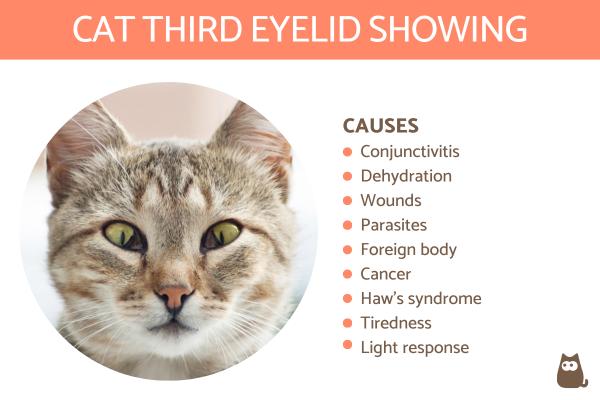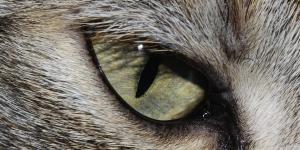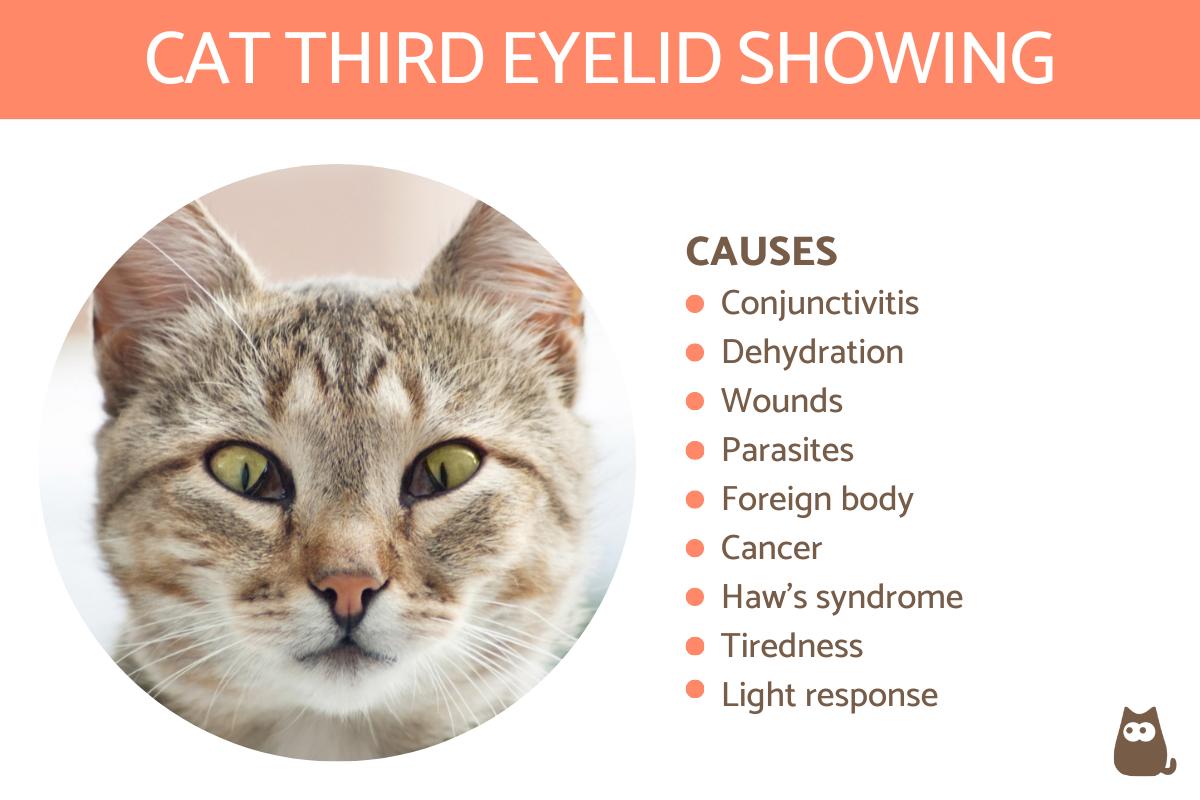Cat Third Eyelid Showing - Causes and Treatment



See files for Cats
The reasons a cat's third eyelid is showing can be benign, but it can also be a symptom of a serious disease. These can be bacterial infections or other diseases which affect the eye directly, but they can also be more systemic. Also known as the nictitating membrane, the third eyelid can appear in one eye or both, depending on the nature of the problem. Other concurrent symptoms can help us to determine the cause of the third eyelid showing. It is also possible for a cat third eyelid showing with no other symptoms. If you are at all unsure, you will need to take the cat to a veterinarian for diagnosis.
At AnimalWised, we look at the causes and treatment of cat third eyelid showing. We stress that it is important this problem is not ignored, especially if we observe other symptoms which indicate a local or systemic illness.
What is the third eyelid in cats?
The third eyelid is the common name for the nictitating membrane (palpebra tertia). It is a tissue located around the cornea, conjunctiva and mucous membrane. It is a translucent or semi-transparent additional eyelid found in various animals, including the cat.
Although you may not notice, you can often see secretions between the eye and the outer eyelids when your cat is half asleep. As they wake up, a cat's third eyelid showing as they begin to open their eyes is normal. However, it should not be visible once open, awake and alert.
The purpose of the third eyelid in cats is not completely understood, but we do know it serves important functions. They include the following:
- Protection: one role of the third eyelid is to protect the eyeballs from any foreign object and from traumas such as when a cat is fighting or playing. The appearance of a third eyelid is instinctive and automatic. It is also responsible for releasing a liquid with antiseptic properties to fight bacteria and microorganisms that could cause disease. However, these protective uses of the third eyelid should not lead to the feline nictitating membrane to show all the time.
- Moisturizing: nictitating membranes are also sometimes known as a 'haw'. In other animals, including many birds, it can be used to moisten the eyeball while open. As it is transparent or translucent, it means the animal can still see. Some mammals have a full third eyelid which can do this, but the cat does not. It is believed that some species have evolved away from using this membrane. Even humans have a vestigial part of their conjunctiva known as the plica semilunaris which is thought to have once been a third eyelid.
If you see that your cat's third eyelid is visible, either in one eyeball or in both, this means that they are in pain or suffering from a condition or disease[1]. Some research suggests that the appearance of this membrane is related to intestinal feline parasites and digestive problems, whereas others state that if this membrane is visible then the problem is related to the eye itself.
In these latter cases, the problem with the cat's inner eyelid could be due to a prolapse[2]. In order for you to have all the information, we will show you the causes that can cause this tissue to appear in your cat's eye.
Causes of third eyelid showing in cats
If you see that your cat's nictitating membrane is visible in one or both eyes, it is usually a symptom of a secondary problem. These are some of the root causes of a cat's third eyelid showing:
- Conjunctivitis: this ocular infection doesn't only cause the appearance of the third eyelid, but is also causes swelling, tearing and lacrimation (tearing).
- Dehydration: when the cat is suffering from a severe lack of water, the appearance of this ocular tissue is a sign and symptom of a serious health condition. They will need to be treated by a specialist who will need to replace fluids and treat the underlying cause of dehydration if necessary.
- Wounds: if your cat has suffered a blow or trauma to the face, both of its eyes may have become affected. Infection is also possible. Take them to the vet straight away to treat infection and repair any damage.
- Foreign body: anything that gets into the cat's eyes, whether plant matter, dust or anything else, will cause the nictitating membrane to appear, as it is a mechanism to prevent it from further embedding into the eyeball.
- Cancer: it's possible for this small organ to be affected by the formation of cancer cells in cats. Fortunately, the disease is relatively rare in this part of the eye. Unfortunately, if it does occur, then it can progress quickly and become fatal[3].
- Haw's syndrome: this name is given to the appearance of the third eyelid when related to an intestinal problem from which the cat is suffering or has suffered from recently. Examples include intense diarrhea in the cat or the presence of parasites. With Haw's syndrome in cats, the third eyelid turns into a protrusion thanks to prolapse. It most commonly occurs in cats less than 2 years of age. Prolapse of the nictitating membrane is one of the most common issues with third eyelids in dogs[4].
- Parasites: an infestation can be one of the causes of haw's syndrome, but the parasites itself are the problem. Different types of cat worms can lodge themselves in the eye, potentially resulting in blindness if not treated promptly.
- Genetics: some cat breeds, such as the Burmese cat, might be prone to suffering a rupture or protrusion of this membrane inside the eye, which is very uncomfortable for them.
- Dermoid cyst: a dermoid cyst is one which is present at birth and can grow slowly as they age. It is usually not observed until secondary symptoms occur. One case study on a kitten with third eye showing from 2016 shows that it can be present on any part of the eye. The result is still protrusion of the nictitating membrane[5]. However, the same study notes that any ocular dermoid occurs infrequently and can respond well to treatment.
The length of time the third eyelid is showing will correlate to the cause. As we said, it may appear for moments after sleeping. However, even once the cat begins treatment, the nictitating membrane may still be visible. This is because the cat's body is taking time to heal.
Furthermore, if you see the third eyelid in your cat it is also highly likely that its eyes will start to tear. They will probably try to touch them with their paws owing to the discomfort caused when this membrane is out of place. So if we see our cat scratching at their face or rubbing it too frequently, we should look to see if we can observe the third eyelid showing.

Cat third eyelid showing in one eye
As a note, if a cat's inner eyelid is showing in one eye and not the other, it is still a cause for concern. It may imply a problem on one side of the body, but it still means there is an issue which needs resolving. It might be that you see a cat's third eyelid showing in one eye which progresses to both. This implies the progression of one of the causes listed above.
If a cat third eyelid showing in one eye is observed, it could be some direct damage to this membrane. This would explain why it is visible in one eye and not the other. It could be a piece of dust which has lodged within or even something hitting it. As we have stated above, cancer is a possible cause of protrusion in the third eyelid, but this is relatively rare. Regardless if a cat's nictitating membrane is observed in one eye or two, you should take them to the vet for evaluation.
Cat third eyelid showing with no other symptoms
If we see a cat's third eyelid appearing due to one of the above reasons, we are likely to see other concurrent symptoms. This could be the presence of a wound on their body or even itching in the case of parasites. However, it is also possible that the cat's third eyelid shows without any other symptoms. This can complicate diagnosis. While it does not always indicate an immediate health emergency, several potential reasons for third eyelids showing without other symptoms:
- Mild Irritation: subtle eye irritation can be caused by minor allergies, dust or exposure to irritants in the environment. These mild irritations can cause the nictitating membrane to become visible temporarily. In these cases, it may resolve on its own as the irritant is cleared from the eye.
- Physical exertion: cats may sometimes exhibit their third eyelid during strenuous physical activity or play. This is generally a temporary response and is not concerning if it occurs during energetic play or exercise.
- Sudden bright light: a cat's pupil adjusts to different lighting conditions. Abrupt exposure to very bright light can cause the nictitating membrane to appear. This is a normal reaction and should subside once the cat adapts to the lighting.
- Sleep or relaxation: cats in a very relaxed state or transitioning between sleep and wakefulness may briefly display their third eyelid. As the cat becomes more alert, it should retract.
- Constitutional anatomy: some cats may naturally have a more visible nictitating membrane due to their individual anatomy. This is usually not a cause for concern as long as the cat's eyes are otherwise healthy.
- Temporary discomfort: the cat may be experiencing mild discomfort that hasn't yet manifested in other symptoms. This could include minor eye irritation, an initial stage of an eye condition or early signs of a systemic issue.
While the visibility of the third eyelid alone may not be an immediate cause for alarm, it is essential to monitor your cat for any changes in behavior, appetite or additional symptoms. If the third eyelid remains visible or if you notice any other concerning signs, you should consult a veterinarian.

Treatment for a third eyelid showing in cats
Owing to the various reasons that can cause the cat's nictitating membrane to occupy more space in the eye than it should, there are several types of treatment. This treatment depends on the source of the problem.
- Dehydration: if a lack of water causes your cat's third eyelid to show, you should give the cat plenty of wet food and water in order to halt the process. It is also recommended to take the cat to the vet if the animal has been lacking water for an extended period of time. They may need additional help such as fluid therapy.
- Disease: some of the common diseases in cats result in the cat's third eyelid to appear. Treatment will depend on the underlying cause. Bacterial infections such as those that cause conjunctivitis will require antibiotic treatment, often in the form of antibiotic eye drops such as Tobrex for cats. Systemic illness may require more invasive treatment such as surgery and/or chemotherapy for cancer. The nictitating membrane should retract after successful treatment.
- Foreign body: since the third eyelid helps to lubricate the eye for this very purpose, the foreign object may remove itself naturally. If it doesn't, the eye will need to be flushed out. If removal is difficult, it may be best to take the feline to a vet.
- Haw's syndrome: the third eyelid should disappear by itself, once the intestinal and digestive problems that caused the appearance of the membrane go away. In turn, this will lead to the nictitating membrane gradually disappearing as the cat returns to health.
- Genetic condition: when a genetic reason is behind cat third eyelid showing, the vet will use various diagnostic tests to determine whether the cat's inner eyelid membrane is affecting the cat's vision and causing discomfort. If this is the case the vet may also resort to surgery. This process will not to extract their third eyelid, but will put the feline nictitating membrane back into its correct position.
If you are unsure of why a cat's third eyelid is appearing, you will need to take them to a veterinarian for assessment. They can confirm the underlying cause and administer the correct corresponding treatment. Learn about another potential eye health problem with our article on corneal ulcer in cat eyes.

If you want to read similar articles to Cat Third Eyelid Showing - Causes and Treatment, we recommend you visit our Eye care category.
1. Muir, P., et al. (1990). A Clinical and Microbiological Study of Cats with Protruding Nictitating Membranes and Diarrhoa. Vet Rec, 127(13), 324-330.
https://www.ncbi.nlm.nih.gov/pubmed/2124013
2. Williams, D., & Middleton, S. (2011). Everted Third Eyelid Cartilege in a Cat: A Case Report and Literature Review. Veterinary Ophthalmology, 15(2), 123-127.
https://www.researchgate.net/publication/51768342_Everted_third_eyelid_cartilage_in_a_cat_A_case_report_and_literature_review
3. Komáromy, A. M., et al. (1997). Primary Adenocarcinoma of the Gland of the Nictitating Membrane in a Cat. Journal of the American Animal Hospital Association, 33, 333-336.
https://repository.upenn.edu/cgi/viewcontent.cgi?article=1046&context=vet_papers
4. Edlemann, M. L., et al. (2013). Investigating the Inheritance of Prolapsed Nictitating Membrane Glands in a Large Canine Pedigree, Veterinary Ophthalmology, 16(6), 416-422.
https://www.ncbi.nlm.nih.gov/pmc/articles/PMC4361898/
5. LoPinto, J. A. (2016). Dorsoally Located Corneal Dermoid in a Cat. JFMS Open Rep, 2(1).
https://www.ncbi.nlm.nih.gov/pmc/articles/PMC5362890/







 My cat has a nictating membrane that is not regrating yet it is well fed.Offer. possible treatment options for conjuvictis in cats
My cat has a nictating membrane that is not regrating yet it is well fed.Offer. possible treatment options for conjuvictis in cats

 Hi! After a brief nap today with the kitties I suddenly noticed Zelda's left inner eyelid wasn't fully retracting. She was fine all day up until now. At first I just assumed she hadn't fully woken up yet, as I know that's normal to see the eyelid when they first wake up, but then she started rubbing her eye and I knew something was up.
Hi! After a brief nap today with the kitties I suddenly noticed Zelda's left inner eyelid wasn't fully retracting. She was fine all day up until now. At first I just assumed she hadn't fully woken up yet, as I know that's normal to see the eyelid when they first wake up, but then she started rubbing her eye and I knew something was up.
 This is my adorable, handsome lil man. I love this baby to the moon and back. He is my heart and my world. The world revolves around him in my eyes. He is very loveable and playful, eats like a pig and sleeps on my chest every night. Well, not long ago he developed some sort of eye infection in one eye and soon spread to the other eye. There was like a yellowish looking mucus coming from his eyes and his 3rd eyelid now covers like half his eye. They were also swollen bad and red. A friend recommended terramycin so that's what I purchased. I put it in his eyes 2-4 daily and now they are no longer swollen or red nor is there any mucus coming from his eyes but the 3rd eyelid is still covering half his eyes. Any suggestions on what to do next? Thanks in advance.
This is my adorable, handsome lil man. I love this baby to the moon and back. He is my heart and my world. The world revolves around him in my eyes. He is very loveable and playful, eats like a pig and sleeps on my chest every night. Well, not long ago he developed some sort of eye infection in one eye and soon spread to the other eye. There was like a yellowish looking mucus coming from his eyes and his 3rd eyelid now covers like half his eye. They were also swollen bad and red. A friend recommended terramycin so that's what I purchased. I put it in his eyes 2-4 daily and now they are no longer swollen or red nor is there any mucus coming from his eyes but the 3rd eyelid is still covering half his eyes. Any suggestions on what to do next? Thanks in advance.


